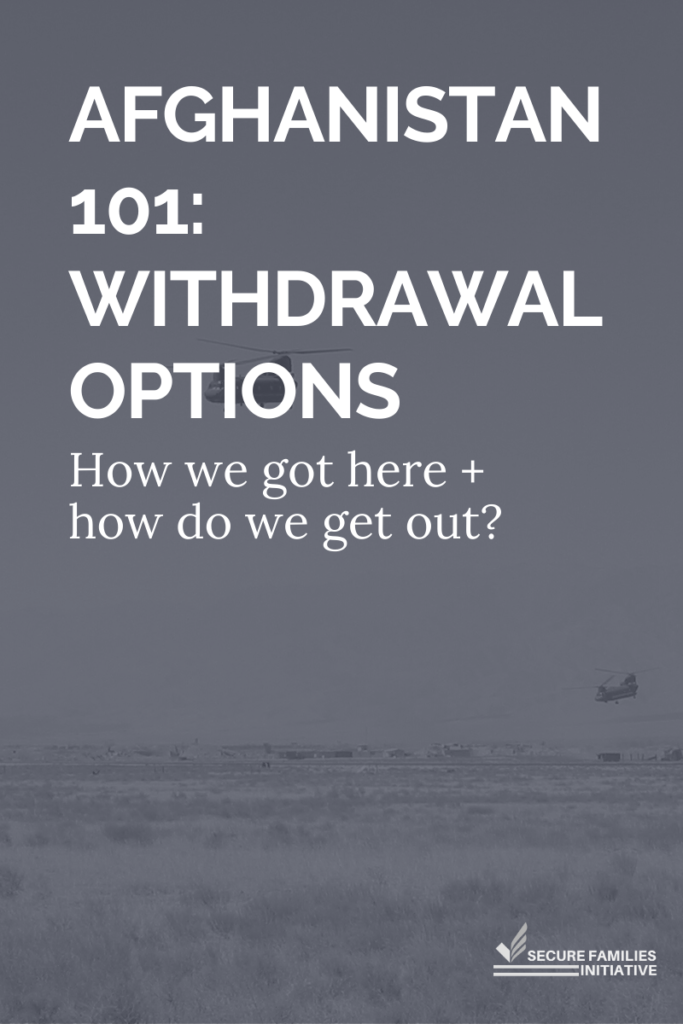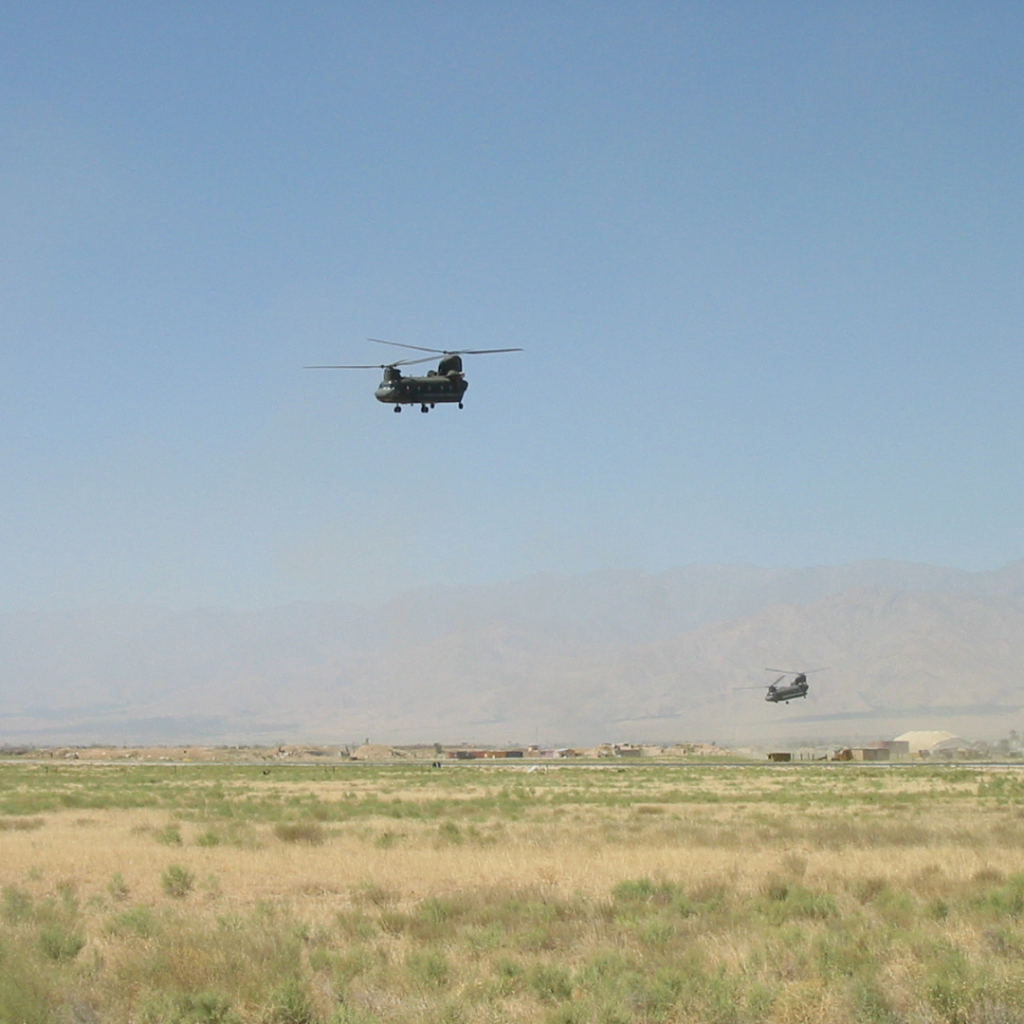One of the most pressing foreign policy issues facing Congress and the White House right now is Afghanistan. Specifically, whether to fully withdraw U.S. troops from the country by the current target date of May 1, 2021.
The War in Afghanistan, and the subsequent years of U.S. military involvement in the region, have left post-9/11 veterans and military families battered, strained, and in some cases permanently altered. Given this topic’s obvious salience for our SFI community, we wanted to provide a quick overview of this policy area and how we got to where we are today.
Our hope is that this and other SFI resources will empower and equip our members to engage their representatives in Washington on this issue. Because we — more than almost anyone else in America — have a profound stake in the outcomes.
U.S. Troops in Afghanistan Timeline
Here’s an abbreviated timeline of key events from the initial invasion into Afghanistan through to current events:
- September 2001: Authorization of Use of Military Force
President George W. Bush signs into law a joint resolution authorizing the use of force against those responsible for attacking the United States on 9/11. This joint resolution will later be cited as justification for sweeping measures to combat terrorism, including the invasion and military action in Afghanistan. - October 2001: War Campaign Begins
The U.S. military begins a bombing campaign against Taliban forces in Afghanistan, officially launching Operation Enduring Freedom. Two weeks later, ground forces arrive. - March 2002: Shift toward Iraq
Nearly 2,000 U.S. and 1,000 Afghan troops battle al-Qaeda and Taliban fighters as part of Operation Anaconda. Meanwhile, Pentagon planners begin shifting military and intelligence resources away from Afghanistan to Iraq and Saddam Hussein. - May 2003: “Major Combat” Over
The Pentagon declares an end to “major combat,” and President George W. Bush’s declares “mission accomplished” and an end to fighting in Iraq. There are 8,000 U.S. soldiers stationed in Afghanistan at this point. - July 2006: Violence Surges
Violence increases across Afghanistan. The number of suicide attacks quintuples and remotely-detonated bombings more than double in 2006. Despite a string of Afghan election successes, some experts blame a lack of strong government for the spike in attacks. - February 2009: Obama Recommits to Afghanistan
New U.S. President Barack Obama announces plans to send 17,000 more troops to the war zone. Obama reaffirms campaign statements that Afghanistan is the more important U.S. battle against terrorist forces. - December 2009: Afghanistan Surge
President Obama announces a major escalation of the U.S. mission and commits an additional 30,000 forces to the fight in Afghanistan. Obama argues that this temporary surge will force Afghan political and military institutions to assume responsibility for their own affairs. - May 2014: Timetable for U.S. Troop Withdrawal
President Barack Obama announces a timetable for withdrawing most U.S. forces from Afghanistan by the end of 2016. - August 2017: Trump Commits to Afghan War
President Donald Trump outlines his Afghanistan policy and commits to an open-ended military commitment to prevent the emergence of “a vacuum for terrorists.” Trump says decisions about withdrawal will be based on “conditions on the ground,” rather than arbitrary timelines. - February 2020: U.S., Taliban Sign Deal on Path to Peace
The U.S. envoy and the Taliban sign an agreement in Doha that projects a significant drawdown of U.S. troops in Afghanistan and includes guarantees from the Taliban that the country will not be used for terrorist activities. The purpose of this agreement was to set the stage for additional peace negotiations between the Taliban and the Afghan government directly. - February 2021: Withdrawal agreement looms
2,500 troops are still stationed in Afghanistan — the lowest levels since the conflict began in 2001. The U.S.-Taliban peace agreement calls for a complete withdrawal of U.S. troops by May 1 of this year.
U.S.-Taliban Doha Agreement on Complete U.S. Withdrawal
There are currently 2,500 U.S. troops in Afghanistan, along with 6,346 U.S. contractors. (For reference, U.S. force levels peaked in 2011 when 100,000 troops were in country.) Under the withdrawal agreement signed by the Trump administration and the Taliban in February 2020, there should be no U.S. troops left in Afghanistan by May 1, 2021.
According to the U.S.-Taliban agreement, the complete U.S. withdrawal is conditional on the Taliban’s separation from international terrorist organizations, such as al-Qaeda, and on the Taliban preventing activities on Afghan soil that “threaten the security of the United States and its allies.” However, the Taliban continues to carry out violent attacks against Afghanis in direct violation of the agreement.
Notably, there are currently more NATO troops than U.S. troops in Afghanistan right now. NATO Secretary-General Jens Stoltenberg has stated that the Taliban has to do more before foreign troop withdrawal. “We see that there is still a need for the Taliban to do more when it comes to delivering on their commitments… to make sure that they break all ties with international terrorists,” Stoltenberg said.
Some U.S. officials seem inclined to agree. “The violence is too high in Afghanistan. That’s the bottom line,” said Pentagon spokesman John Kirby.
Biden Administration Options
The Biden administration is currently reviewing the U.S.-Taliban agreement and the situation on the ground in Afghanistan. With the May 1 deadline looming, they face a difficult decision between three basic options:
- Abide by the timeline laid out in the U.S.-Taliban agreement and withdraw U.S. forces as scheduled by May 1;
- Pull out of the agreement, pointing to Taliban violence as justification, and maintain an indefinite U.S. military presence; or,
- Negotiate a delay to the withdrawal of troops to create space for more diplomacy with the Taliban, the Afghan government, and NATO. Form a new withdrawal timeline based on the Biden administration’s goals and terms.
None of these options is perfect. Each path forward comes with risks and trade-offs.
The recent deterioration of conditions on the ground in Afghanistan has motivated some to argue that the U.S. should maintain a troop presence past May, ideally by negotiating a temporary extension. Doing so could reinforce the Afghan government’s defenses against encroaching Taliban attacks, and would make clear that the conditions negotiated at Doha matter.
However, even this middle-of-the-road approach is not without its risks. The Taliban has repeatedly made clear that extended foreign troop presence would be seen as an act of aggression that would beget a violent response, potentially drawing the U.S. back into a wartime footing. As a result, many peace and security advocates see the current moment as the best opportunity in two decades for the United States to extricate our military from this exhaustingly protracted conflict.
What this Means for Families Like Ours
Unfortunately, no matter which path forward the White House chooses, it is unlikely that the end result for Afghanistan will live up to the hopes of U.S. military families who have endured deployments to this region. Our community deserves the chance to grieve that tragic fact.
With that in mind, leaders are looking to veterans and military families right now to weigh in on what steps forward best reflect our community’s needs and interests. We hope you will take this window of opportunity to engage with your representatives in Congress about this issue. This is the seat at the decision-making table that we’ve been fighting for.


